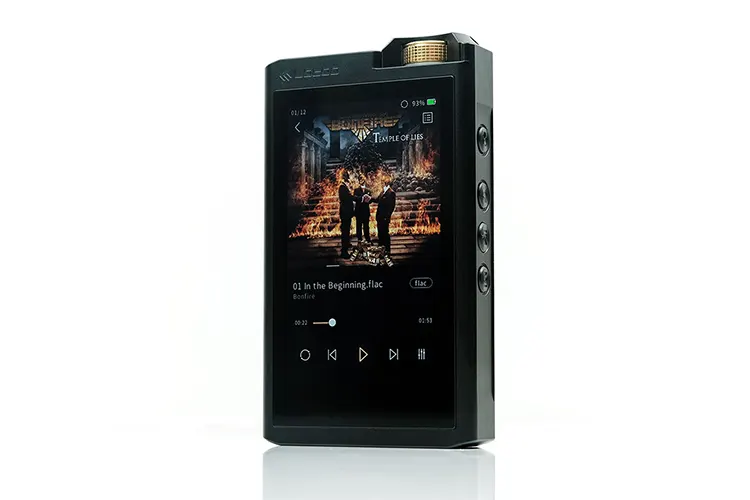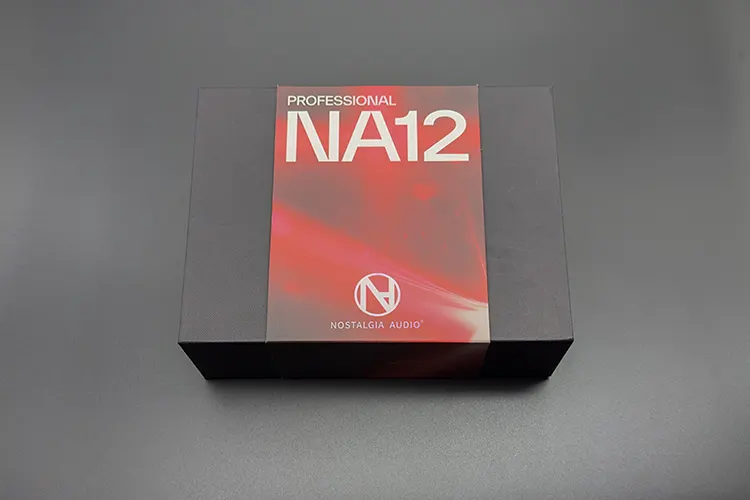Synergy
Efficiency
Nostalgia Audio NA12 has a sensitivity of 116 dB @ 1kHz, 1mW, and an impedance of 18 Ω @ 1kHz. It’s quite easy to drive, requiring no extra power.
Even with the inclusion of electrostatic drivers, the NA12 doesn’t scale much with more powerful sources and can be easily powered by less demanding devices like dongles or smartphones.
While power specifications are not critical, the NA12 benefits more from the quality of the source rather than its power output. A neutral source provides the best results, as warmer sources can introduce a veiled and fuzzy presentation.
Source Pairings
Among the sources I tried, the NA12 performed well across the board. Paired with the LPGT, the NA12’s bass benefits from added texture and impact, while the midrange remains pleasant and true to the IEM’s character without being overly warm.
The LPGT reveals the NA12’s best resolution and detail, though the soundstage width doesn’t improve much with this pairing, despite good depth.
With the Questyle CMA18P, featuring an AKM DAC chipset, the NA12 maintains a solid pairing. The bass is similarly well-textured, though it feels tighter on the LPGT.
The midrange is more neutral, with a touch more bite in the upper midrange and lower treble. While the LPGT portrays finer details more prominently, the CMA18P offers a slightly wider soundstage.
The Astell&Kern SP3000 is an ideal match for the NA12, offering a neutral character that complements the IEM’s low power requirements.
The synergy here is excellent, with a notably wider soundstage that feels enveloping. The resolution is superior, and the treble is airier with more sparkle, enhancing detail without fatigue.
Select Comparisons
FlipEars ARTHA
Technical
The ARTHA is an all-BA IEM with 8 custom Sonion balanced armature drivers. There are two drivers each for sub-bass, bass, midrange, and high frequencies.
It has an impedance of 16Ω and a sensitivity of 118 dB @ 1mW, making it similarly easy to drive as the NA12. ARTHA features two tuning switches per side, allowing for four different tuning options, with the 0-1 mode adding a touch of airiness.
For the comparison, I am using the 0-1 mode, which adds a bit of airiness to the sound.
Design
ARTHA employs a Conoid Resonative Chamber (CRC) nozzle design, crafted to elevate sound quality but may be challenging to fit for some users due to its unique shape.
Visually, ARTHA’s multi-colored and shiny abstract faceplate stands out against the simpler design of the NA12. In terms of build, ARTHA feels more robust and has smaller shells than the NA12.
Both IEMs use 0.78mm 2-pin connectors, but the NA12’s cable is of higher quality with a better finish. Flipears provides a solid accessory set with the ARTHA, including in-house ear tips and Eletech Baroque tips, along with a premium rectangular leather case.
In comparison, the NA12’s accessories inclusion feels equally thoughtful, though it lags behind in terms of presentation.
Performance
In terms of sound, both IEMs share a focus on a relaxed, musical tuning rather than an analytical one. ARTHA provides more warmth and smoothness, with a bass that mimics a dynamic driver, offering substantial impact and slower decay.
The NA12’s bass is drier and quicker, tighter, and more controlled, though both IEMs emphasize mid-bass and lack deep, rumbly sub-bass. On the bassier tuning modes, ARTHA’s bass can bleed into the midrange, slightly overshadowing details.
ARTHA’s midrange stands out with a realistic, natural timbre that gives vocals a prominent, lifelike presence. The NA12 has a similar midrange but lacks the richness and fullness of ARTHA. Its vocals are more balanced and less pronounced, with a less dense, warmer presentation than ARTHA’s.
While both IEMs perform similarly in terms of resolution and detail, ARTHA’s extended midrange and extra bite in the upper midrange and lower treble offer better clarity and an enhanced sense of detail, making it more enjoyable overall.
In the treble, both IEMs provide a smooth, non-fatiguing experience. ARTHA handles the lower treble with more clarity and liveliness, while both IEMs offer a similar sense of airiness in the upper frequencies.
It’s tough to say which one excels technically. Both IEMs have a depth-focused soundstage, offering a natural width without sounding overly wide. ARTHA’s resolution is a bit superior, though the NA12 excels in imaging, presenting a more defined instrument placement.
Nostalgia Audio Camelot
Technical
Nostalgia Audio Camelot is a tribrid IEM, consisting of two 10mm Dynamic Drivers, four balanced armature drivers, and four electrostatic drivers.
Camelot uses a 5-way crossover design, including a dynamic driver for the ultra-lows, another for the lows, 2 BAs for mids, 2 BA for highs, and 4 EST drivers for the ultra-high frequencies.
It boasts features such as XBS (Extreme Bass System) and SFD (Spiral Flow Device) technology, for providing a detailed tonal balance and smooth vocals.
Camelot has an impedance of 13 Ω @ 1kHz and a Sensitivity of 116dB which is comparable to the specifications on NA12. I find the drivability nearly similar on both the IEMs.
Design
Both the NA12 and Camelot share a similar design language. The Camelot features a simplistic design with black shells and an elegant faceplate adorned with a refined logo.
The shape and size of the shells are quite comparable, though the NA12 is noticeably lighter. Both IEMs feature long nozzles, with the Camelot having a 4-bore nozzle, while the NA12 uses a 3-bore design. The Camelot feels a bit more robust, with a slightly heavier build.
Both IEMs use a 0.78mm 2-pin connector for cable attachment, but the Avalon cable included with the Camelot is more rugged compared to the NA12’s cable. The Avalon cable is constructed with 4 strands of 22 AWG high-purity OFC and OCC copper, offering a more premium feel.
I prefer the aluminum carry case that comes with the NA12, but the Camelot’s handcrafted leather case also exudes a high-end, premium quality.
Performance
Upon comparison, it’s clear that both IEMs have a similar tuning, with subtle differences. The NA12 is primarily a technically focused IEM, but to label it as less musical would be inaccurate.
With two dynamic drivers in the Camelot versus balanced armature drivers handling the bass in the NA12, there are clear distinctions.
The dynamic drivers in the Camelot provide more natural bass with better decay, impact, and well-rounded sub-bass and mid-bass. The NA12 is not far behind, however, with a decent decay and impact of its own. The quality of bass is slightly better on the Camelot.
In the midrange, both IEMs are very similar, offering similar warmth. The NA12 is a bit more neutral in the midrange, but the timbre and overall presentation are quite comparable.
Both share a similar sweetness in trailing notes, and their resolving capabilities are nearly identical, making it difficult to distinguish between their midranges in a blind test.
When moving to the upper midrange, the Camelot deviates in its presentation. It has more bite and energy, and its extension is slightly better, carrying this through to the treble region.
The treble on the Camelot has an extra bit of energy and air, especially in the upper treble range. This added presence, aided by two additional EST drivers, enhances the clarity and detail of the Camelot, allowing it to discern finer details more effectively.
Soundstage-wise, the NA12 offers slightly better depth, while the Camelot excels in width. Both IEMs provide a similar 3D effect.
The Camelot has an airier upper frequency, giving it a sense of openness, while the NA12 has slightly more focused depth. Overall, the technical aspects of both IEMs are quite comparable, with excellent imaging and layering on both.
64 Audio U12T
Technical
The U12T is one of the most renowned IEMs in 64 Audio’s lineup, released a few years ago but still highly regarded.
It’s an all-balanced armature IEM with a total of 12 drivers—1 tia High Driver, 1 High-Mid Driver, 6 Mid Drivers, and 4 Low Drivers. It also features a 4-way crossover and includes the APEX module system with three variations: mX, m15, and m20.
The U12T has a sensitivity of 108 dB/mW at 1kHz, and I find it requires just a bit more power than the NA12.
Design
The U12T shells are machined from a solid piece of aluminum and finished with an elegant, brushed faceplate. This build quality is more robust than the resin shells of the NA12.
Both IEMs share a simplistic aesthetic. The U12T shells are smaller and fit better, in my opinion. The U12T’s nozzles are longer, though narrower compared to the NA12.
They both use a 0.78mm 2-pin connector. The U12T comes with a 26AWG silver-plated OCC copper wire. The NA12’s 4.4mm terminated silver cable feels slightly more premium and also outperforms the U12T stock cable in terms of sound quality.
Performance
The U12T offers a very clean and transparent presentation, with just a touch of warmth that doesn’t overwhelm its neutral character. In contrast, the NA12 offers more warmth, providing a sound that’s less clinical than the U12T.
Starting with the bass, the U12T boasts one of the best bass responses for an all-BA IEM. It’s fast, controlled, and well-defined.
The NA12, on the other hand, has a slightly warmer, thicker bass. The U12T has more slams in the mid-bass and has a deeper sub-bass presence, while the NA12 offers a more voluminous bass with less definition and a smoother attack.
In the midrange, the NA12 has more warmth and a natural, fuller presentation. The vocals and instruments feel more prominent and denser. The U12T, while maintaining neutrality in the midrange, offers greater resolution and reveals more detail.
For listeners seeking a more musical IEM, the NA12 would likely be more appealing. The upper midrange of the U12T extends quite well, however can occasionally result in a thinner sound.
The U12T leans more toward a treble-focused sound, whereas the NA12 maintains a more subdued treble profile. The U12T has more air and detail in the treble, but it can sometimes feel a bit exaggerated.
This is where source synergy becomes crucial—on my LPGT, I enjoy the U12T’s treble. The NA12 presents a more relaxed treble, which lacks the sharpness and shimmer of the U12T but has a smoother, less fatiguing feel.
Technically, it’s tough to choose which IEM performs better. One area where the U12T falls short is its soundstage, which feels rather flat, and lacking depth.
In comparison, the NA12 offers a more expansive stage with better depth and a more immersive feel. The U12T excels at imaging and resolution, while the NA12 shines with its more spacious stage, giving instruments room to breathe and allowing for better layering.
My Verdict
Having tried the Camelot several times and thoroughly enjoying its tonality and timbre, I had high expectations for the NA12.
My interest was piqued further by its status as part of the professional series, and having experienced other professional monitors, I was eager to try the NA12. It did not disappoint.
The Nostalgia Audio NA12 strikes me as leaning more toward an audiophile-grade sound, with warmth and smoothness that balances the technicality expected from a professional-grade IEM.
It offers an excellent combination of soundstage, imaging, and timbre that makes it enjoyable for audiophiles, while still retaining the technical capabilities expected from a professional monitor.
The NA12 shares a similar sonic character to the Camelot, though I wish the bone conduction driver would have made its presence more noticeable; its contribution to vibrancy is minimal, and it could be more prominent.
Overall, I’m confident that Nostalgia Audio has honed its tuning skills, and it’s a brand I’ll be keeping an eye on in the future.
Nostalgia Audio NA12 Specifications
- Driver Configurations: 8 Balanced Armature drivers, 2 Bone Conduction Vibrator, 2 EST drivers
- Frequency Response: 15 Hz – 48 kHz
- Impedance: 18 Ω @ 1 kHz
- Sensitivity: 116 dB @1kHz
- Crossover: six-way
- Cable: 4.4mm: 26 AWG High Purity Silver Plated Copper, 5mm: Silver-plated cable






